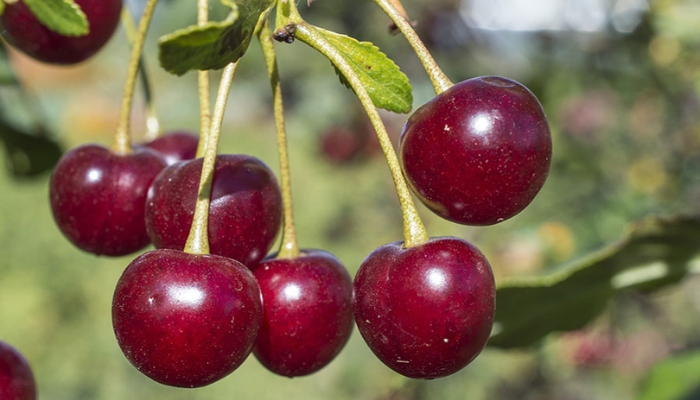The cherry is one of the most popular fruits in the world, summer, rich in flavor and very versatile. Year after year, hundreds of tons are produced, imported and exported for consumption, which can be made in different varieties. In Europe alone, it is estimated that there is an approximate consumption of 700,000 tons, and in Asian countries such as China, it is a highly relevant symbol in festivities such as the Chinese New Year.
Its popularity, of course, has expanded over the years, and with the appearance of new producers, who, in turn, specialize in different varieties. More or less sweet, reddish and yellow in color, the different cherries that exist are recognized by their unique characteristics and their appearance is born from the delicacy of the fruit and how it adapts to different contexts, climates and environments.
The weather, for example, affects the ripening and harvesting time of cherries. During winter, cherry trees need to accumulate cold hours to bloom properly in spring. An excessively warm winter will delay the cherry blossom season. Between the harvest of one variety or another, can it be even 50 days of difference.
Early Varieties
They are considered early cherries, those that are harvested before the Burlat Cherry, known to be one of the main ones in Europe, and one of the early varieties par excellence.
Cavalier
This early-ripening cherry has a dark red fruit that is medium size, firm and high quality. It should be planted in Gisela rootstocks since they have low productivity in vigorous rootstocks. Bacteria canker tolerance and winter hardiness are good, as well as the resistance to cracking. Self-infertile, in the Polen IV (S2S3) Group, with an early blooming season; multiple pollinators are recommended.

Chelan
This cherry has a moderate quality, dark mahogany red, firm fruit, of great to moderate size. The fruit must be allowed to ripen completely in order to get the best flavor. Productivity is very good, resistance to cracking is good and trees are more resistant to powdery mildew. Self-infertile, in the Pollen XVI (S3S9) Group, with an early blooming season.

Kristin
With a ripening at the beginning or mid-season it has a moderate size, firm, dark red and flavorful fruit. Its resistance to winter is excellent, and the fruit has a moderate to good resistance to rain-induced fruit cracking. Self-infertile, it is in the Pollen III (S3S4) Group, with an early to medium blooming season.

Mid-Season Varieties
The cherry of medium maturation season, matures between 12 and 19 days, after the Burlat Variety. The prices of these varieties are usually very profitable, and its flavor it’s still really good, with less chances of cracking.
Benton

This mid-season ripening cherry has dark mahogany red fruit, firm, of a great size with a good flavor. Yield has been consistently high in trials in New York. The resistance to cracking is very good. It is self-fertile, with a medium to late blooming season.
White Gold

This ripening blush cherry has a clear yellow-colored flesh with a firm yellowish-red skin blush, moderate to large in size, and good flavor. The trees are very productive, resistant to cold and well adapted to the growth conditions of Eastern North America, with a low susceptibility to cherry leaf spot and bacterial canker. The fruit is moderately tolerant to rain. Self-fertile, with a mid to late blooming season.
Glacier

The Glacier is known for its large fruits that are dark mahogany red in color with very good flavor, but less firmness than other fresh market varieties. «Glacier» could be an excellent fruit for local markets with fresh products. It should be grown on early rootstocks that control the size. Moderately susceptible to rain. Self-fertile, with a mid to late blooming season.
Lapins

Has a fruit that is dark mahogany red in color with good flavor and excellent firmness. Lapins produces exceptional fruit for immediate sales locations. It has had surface pitting problems when it is shipped from the west coast. In New York it also suffered lesions in the 2003 and 2004 winter. However, it is a productive variety, self-fertile and exceptional and is very rain tolerant.
Late Variety
Late Cherry ripens between 20 and 27 days after Burlat. Late commercial varieties usually have very good flavor, high productivity and good resistance to cracking, but their prices are usually lower in comparison to other varieties.
Regina

This late-ripening cherry is a new variety that is more promising for the East. The fruit is large, dark red in color, very firm with a long stem. It’s very tolerant of rain. It is a late bloomer, which helps it to avoid frost, but it requires a variety of pollinators that also bloom late. In places like Hudson, growers have worked very well in trials in Geneva. It is a timid cultivar unless grown in one of the Gisela populations.
Sweetheart

Considered as a very late-season ripening cherry, this fruit has a very high quality, a brilliant red color, firm and good flavor, but the size is moderate. A tree that is easy to grow, with an extended shape and early, heavy crops on all rootstocks. It has a good winter resistance and bacterial susceptibility to canker and the fruit is moderately resistant to cracking. The tree is self-fertile, with a mid-season bloom. In Gisela rootstocks, it is often too productive and requires load management of the crop to achieve an acceptable size.
To find more details about these and other cherries varieties you can visit https://treefruit.wsu.edu/web-article/cherry-varieties/










